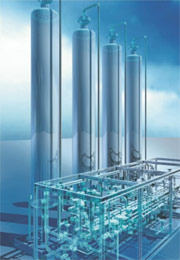A Hydrogen has many industrial uses and may one day replace fossil fuels such as gasoline to power vehicles without emitting carbon dioxide. But finding an environmentally friendly way to produce hydrogen in large quantities is still a big challenge. Traditionally, industrial amounts of hydrogen are produced by splitting methane, a process that depends on fossil fuels and creates carbon dioxide as a byproduct.
At Idaho National Laboratory, a team of engineers is working to develop a greener process, splitting steam into hydrogen and oxygen using high-temperature electrolysis. Coupled to an advanced nuclear plant, high-temperature electrolysis would use heat and a portion of the plant's electricity to generate hydrogen. "This is a way to produce hydrogen without producing carbon dioxide," says Stephen Herring, the INL nuclear physicist who heads up the High-Temperature Electrolysis project, part of the Department of Energy Office of Nuclear Energy's Nuclear Hydrogen Initiative.
The laboratory's High-Temperature Electrolysis team recently completed the first test of its Integrated Laboratory Scale (ILS) experiment, a scaled, high-temperature electrolysis hydrogen plant. Standing beside the ILS, Herring points out the system's pumps, control systems, heating elements and electrolysis cells, which operate at 800 degrees Celsius.
"This is everything but the reactor, only on a smaller scale," he says. When operated at full capacity later this year, the ILS plant will generate roughly 500 grams of hydrogen an hour. "That doesn't sound like much, but hydrogen is light stuff," Herring says. The lessons the team learns with the ILS will help them design a full-scale plant capable of producing two-and-a-half kilograms of hydrogen each second. For automobiles, a kilogram of hydrogen contains roughly the same amount of energy as a gallon of gasoline.
Creating an Integrated Laboratory Scale experiment
Because water breaks apart more easily when heated, electrolyzing water at high temperatures is more efficient than traditional electrolysis. But designing components that perform well at high temperatures can be difficult. To produce hydrogen, Herring and his colleagues use fuel cell-like materials. In each solid oxide cell, a voltage pulls oxygen ions through a ceramic electrolyte, effectively separating the steam into hydrogen and oxygen. The team is working with Ceramatec, Inc. in Salt Lake City to produce the cells.
The high-temperature electrolysis experiment began four years ago with a single, small button cell about an inch in diameter. Since then, the team has changed the geometry of the cells from single buttons to a series of stacks. Steam is pushed through every other layer of stacks and is split to produce hydrogen and oxygen. On the other side of the ceramic membrane, the oxygen ions that have migrated through the ceramic electrolyte are carried away using normal air. The geometric change from single cells to stacks was a crucial step. "We've gone up a factor of 15,000 in hydrogen production from the little button cells we had to what we have now," Herring says, "but we have another factor of 15,000 still to go."
The ILS experiment will incorporate 720 cells that will fit in a hotbox the size of a steamer trunk. When running at full power, the ILS will consume 15 kW of energy to power the electrolysis cells that will produce its hourly 500 grams of hydrogen. The team is working on ways to reduce that energy by making the electrolysis cells more efficient. They also plan to add heat exchangers to transfer heat from the end of the ILS to heat up water at the beginning. Creating that cyclical process will reduce the power needed to make steam, enabling the system to use 20 percent less electricity than it does now.
The biggest challenge will be to make solid oxide cells that can resist corrosion. Constant use in a demanding, high-temperature environment quickly reduces how efficiently the cells produce hydrogen. The team has tested stacks of cells that have operated for as many as 2,000 hours, or three months. But to make a commercial high-temperature electrolysis plant cost-effective, Herring says, the cells must run for two years. The team is now preparing to dismantle cells from the first ILS test to look for ways to reduce degradation. Pieces will be sent to Argonne National Laboratory, the University of Nevada at Las Vegas, and Ceramatec, Inc. in Salt Lake City to be examined.

